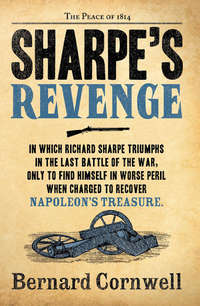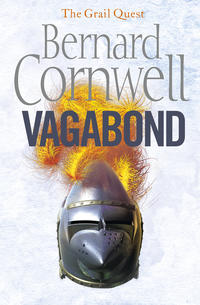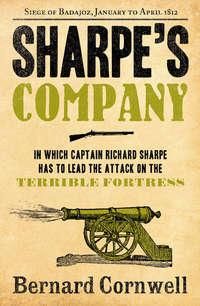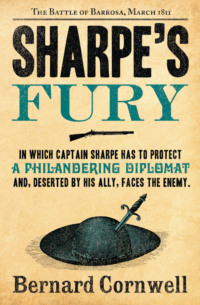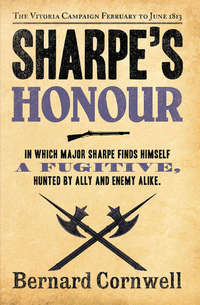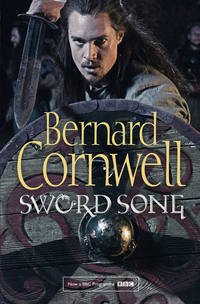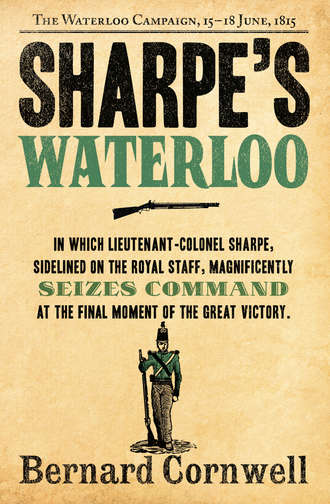
Полная версия
Sharpe’s Waterloo: The Waterloo Campaign, 15–18 June, 1815

SHARPE’S
WATERLOO
Richard Sharpe and the Waterloo Campaign, 15 June to 18 June 1815
BERNARD CORNWELL


This novel is a work of fiction. The incidents and some of the characters portrayed in it, while based on real events and figures, are the work of the author’s imagination.
HarperCollinsPublishers Ltd.
1 London Bridge Street
London SE1 9GF
www.harpercollins.co.uk
First published by HarperCollinsPublishers 1990
Copyright © Rifleman Productions 1990
Foreword © Bernard Cornwell 2015
Bernard Cornwell asserts the moral right to be identified as the author of this work
A catalogue record for this book is available from the British Library
All rights reserved under International and Pan-American Copyright Conventions. By payment of the required fees, you have been granted the non-exclusive, non-transferable right to access and read the text of this ebook on-screen. No part of this text may be reproduced, transmitted, down-loaded, decompiled, reverse engineered, or stored in or introduced into any information storage and retrieval system, in any form or by any means, whether electronic or mechanical, now known or hereinafter invented, without the express written permission of HarperCollins ebooks
HarperCollinsPublishers has made every reasonable effor to ensure that any picture content and written content in this ebook has been included or removed in accordance with the contractual and technological constraints in operation at the time of publication
Source ISBN: 9780007452903
Ebook Edition © JULY 2009 ISBN: 9780007338764
Version: 2017-04-25
Sharpe’s Waterloo is for Judy, with all my love
Contents
Cover
Title Page
Copyright
Dedication
Epigraph
Foreword
Maps
The First Day: Thursday, 15 June 1815
Chapter One
Chapter Two
Chapter Three
Chapter Four
Chapter Five
Chapter Six
The Second Day: Friday, 16 June 1815
Chapter Seven
Chapter Eight
Chapter Nine
The Third Day: Saturday, 17 June 1815
Chapter Ten
Chapter Eleven
Chapter Twelve
The Fourth Day: Sunday, 18 June 1815
Chapter Thirteen
Chapter Fourteen
Chapter Fifteen
Chapter Sixteen
Chapter Seventeen
Chapter Eighteen
Chapter Nineteen
Chapter Twenty
Epilogue
Historical Note
Sharpe’s Story
Keep Reading
About the Author
The SHARPE Series (in chronological order)
The SHARPE Series (in order of publication)
Also by Bernard Cornwell
About the Publisher
‘A brilliantly imaginative novel which sweeps you along at breakneck speed’
Mary Wesley
FOREWORD

I wrote Sharpe’s Waterloo in 1990 and found it a most frustrating book. I had devised a plot (much of it revolving around Lord John Rossendale, Sharpe and Jane), but quickly discovered that no plot of mine could compete with the dramatic story of the battle itself. The whole story, from the first shots of the campaign to the collapse of Napoleon’s army, took place in just four days, and those four days saw four battles (Ligny, Quatre Bras, Wavre and Waterloo). There was to be more fighting as the allies advanced on Paris, but essentially Napoleon’s ambitions and the hopes of France collapsed on the ridge of Mont St Jean on the evening of 18 June 1815.
The two leading characters of Waterloo are as compelling as the battle itself. By 1815 no one would have denied that the two greatest soldiers of the age were Napoleon and Wellington. Napoleon had engulfed Europe in war, leading his eagles from Madrid to Moscow, shattering armies, toppling thrones and gaining such great triumphs as Friedland and Austerlitz. His armies moved fast, he had a talent for spotting and exploiting an enemy’s weakness, he was an inspiration to his men, and his presence on the battlefield, the Duke of Wellington reckoned, was worth 40,000 men. He was extraordinarily hard-working, had a genius for administration, and his legislative accomplishments still command much of Europe, but above all else he was a warlord. He gave France what she craved, la gloire! His ambitions were gargantuan, leading to such spectacular failures as the Russian campaign of 1812, but no one doubted his talents. In 1814, as the allies gradually tightened their noose about Paris, he dazzled them with his lightning marches and sudden assaults. He was, as his enemy Czar Alexander called him, ‘the world’s Conqueror’.
But Czar Alexander also called Wellington ‘the Conqueror of the world’s Conqueror’. The Duke was not flamboyant like the Emperor, he did not rouse fervent adulation from his men, he even had a reputation as a cautious general, but he was a general who, unlike Napoleon, had never lost a battle. He had a wealth of common sense, a talent for reading ground, and a care for his troops which they rewarded with dogged loyalty. His enemies scorned him as a defensive general, and it is true that a quick way to lose any battle was to attack the Duke in a position he had decided to defend, but at Assaye, Salamanca and Vittoria he had shown he could attack with a panache and daring the equal of Napoleon’s. He and the Emperor were both forty-six years old in 1815, and both men had been fighting for their entire adult lives, yet they had never met in battle. No one doubted they were the two greatest generals of the era, but if they met, who would prove the greater? That drama is also part of the story of Waterloo, and made more dramatic by the knowledge that each man knew the reputation of the other. They were fighting for posterity’s judgement as well as the fate of nations.
And the battle has a cliff-hanger of an ending. Waterloo was, as the Duke often admitted, a very close-run thing. ‘It was the most desperate business I was ever in,’ he wrote to his brother William after the battle. ‘I never took so much trouble about any battle, and was never so near to being beat.’ Since late morning the French had assaulted the Duke’s position, attack after attack, each one wearing the thin red line ever thinner, until at last, around 7.30 p.m. on the evening of 18 June, the Emperor launched his Imperial Guard against Wellington’s right flank. The Imperial Guard! They were the elite of Napoleon’s army, deeply experienced, proven brave, fervently loyal and protecting the reputation of being unbeatable. When in trouble Napoleon sent in the Guard and again and again they had won his battles. They were the famous ‘immortals’, and as the sun went lower across a battlefield heated by the great guns, shrouded by smoke and littered with corpses, the Imperial Guard was sent to break the Duke’s army. What happened next is one of the great passages of arms and the culmination of that most desperate business.
So it is a magnificent story, but I would be the first to admit that the version told in the novel Sharpe’s Waterloo is skewed by Sharpe’s point of view. He is fiercely protective of the British army and, like many of the battle’s British survivors, is scornful of his allies (with the exception of the King’s German Legion which was regarded as every bit as good as the British army). The Prussians are acknowledged as helpful, but blamed for being late. Waterloo, then, is depicted as a British victory. I knew, when I wrote the novel, that this was a distortion but Sharpe would have shared the prejudices of the rest of the army. Then, two years ago, I wrote Waterloo: The History of Four Days, Three Armies and Three Battles, a non-fiction account of the events described in the novel and, of course, the viewpoint is very different (The ‘Three Battles’ in the title are Ligny, Quatre Bras and Waterloo as the book more or less ignored the battle of Wavre altogether). The truth is that Waterloo was essentially an allied victory. Wellington would never have defended the ridge at Mont St Jean if he had not been totally confident that the Prussians were coming to his aid, and Blücher would never have marched to Mont St Jean if he had not believed that Wellington would stay and fight. For both men the decisions were brave and difficult, and if either had mistrusted the other then the campaign would have been lost. Yes, it is true that the Prussians took longer to arrive than either Wellington or Blücher had hoped, but that late arrival, though it stretched Wellington’s resources perilously thin, also doomed the French because, by the time the Prussians attacked, Napoleon’s army was wholly committed to the attack on Wellington’s position and had no chance of disengaging. A defeat turned into a rout.
Waterloo ended the long world war which had seen both Washington and Moscow burned. The Revolutionary and Napoleonic wars were the culmination of fifty years of intense rivalry between Britain and France and the war’s outcome was a British triumph, so it is not unsurprising that Waterloo was depicted by the British as their triumph rather than as an allied victory. Nowhere illustrates that better than the fight at Hougoumont. The château was garrisoned by Dutch and British troops. The Dutch were posted ahead of the château, guarding the wood which lay between Hougoumont and the French position so, naturally, they were the first to go into action when the French attacked. They were hugely outnum-bered and forced to retreat. They could not enter the château on its northern side (which faced the French) because all the gateways had been blockaded so they ran around the edges of the compound to join the defenders inside the walls. The British saw them running and must have believed they were fleeing. One British Guard’s officer wrote scornfully, ‘the Dutch instantly gave way and fled’. Another Guard’s officer recalled, ‘after the first hour there was not one of them to be seen, they had all vanished.’ That testimony seems fairly clear, the Dutch had fled in panic, but Dutch accounts tell a very different story! A Dutch officer said that his men defended the château and were reinforced by some British Guards who came to ‘support the battalion under my command’, which suggests that the British played a secondary role! Other Dutch accounts confirm that their troops were in the fighting that raged all afternoon and into the evening, but British accounts of the battle rarely gave them any credit. The nineteenth century was to be Britain’s era, she ruled the world, and the battles of Trafalgar and Waterloo were seen as justification for her pre-eminence so the British were loath to share any of the credit for those victories.
It was not Sharpe’s business to be fair to his allies, that would be asking too much of him, and like all the other men who survived that terrible day, his memory was shaky. Men saw little of the battle. Smoke hung thick across the field. For much of the day the allied infantry was sheltered on the reverse slope, unable to see into the valley where the killing took place. And what they did see was often confusing and terrifying. One British infantry officer said he hardly saw a Frenchman all day, just thick skeins of smoke being lit by musket flashes, so his men fired at the flashes. ‘I am endeavouring to do an impossibility,’ one young British officer wrote to his father just afterwards, ‘to describe a battle’. Captain Powell of the 1st Foot Guards was sure his battalion was attacked by 6,000 men of the Imperial Guard, but there could not have been more than 2,000 attackers. Ensign Leeke of the 52nd, who was engaged in the same fight against the Chasseurs, confidently believed they numbered about 10,000. This is not to criticize the men who were there, they were brave and they achieved greatness at Mont St Jean, but their recollections are not always accurate.
Waterloo is a magnificent and terrible story, but it is not just the story of a great British triumph. It is the tale of an allied victory in which the British played a crucial part. When the Duke finally waved his line forward at the end of the day Von Müffling, the Duke’s Prussian liaison officer, recalled, ‘when the line of infantry moved forward small masses of only some hundred men, at great intervals, were seen everywhere advancing. The position in which the infantry had fought was marked, as far as the eye could see, by a red line caused by the red uniforms of the numerous killed and wounded who lay there.’
That is a terrible image, a tideline of dead and dying men.
No one knows how many died at Waterloo, or died of their injuries in the days that followed. A conservative estimate would be that about 12,000 men lay dead as night fell on 18 June, and some 30,000 to 40,000 wounded. Many of those wounded were doomed. The 32nd, a British regiment, had twenty-eight men killed in the battle and 146 wounded, but forty-four of those wounded subsequently died. The Prussians took ghastly casualties at Plancenoit, while the French probably suffered worst of all. They began the battle with close to 77,000 men, but a week or so later the musters showed only 44,000 still with the colours. Many of those missing men had deserted, of course, but far too many were dead or dying.
Harry Smith, the Rifleman hero of the Peninsular Wars, wrote afterwards:
I had been over many a field of battle, but with the exception of one spot at New Orleans and the breach of Badajos, I had never seen anything to compare with what I saw. At Waterloo the whole field from right to left was a mass of dead bodies. In one spot, to the right of La Haye Sainte, the French Cuirassiers were literally piled on each other; many soldiers not wounded lying under their horses; others, fearfully wounded, occasionally with their horses struggling on their wounded bodies. The sight was sickening … All over the field you saw officers, and as many soldiers as were permitted to leave the ranks, leaning and weeping over some dead or dying brother or comrade. The battle was fought on a Sunday, the 18th June, and I repeated to myself a verse from the Psalms of that day – 91st Psalm, 7th verse; ‘A thousand shall fall beside thee, and ten thousand at thy right hand, but it shall not come nigh thee.’
They were all brave men; Prussians, Hanoverians, Dutch, British and French. It was a terrible day, an awful battle, and no wonder that afterwards the Duke of Wellington was to say ‘I pray to God I have fought my last battle’.
He had. And in winning his last, most desperate, battle he bequeathed us a magnificent story. The one you’re about to read is not inaccurate, merely one-sided. Sharpe and his companions fought desperately, that tideline of red uniforms was mute witness to their bravery, but so did the Dutch, the Hanoverians, the Prussians and the French.
Waterloo was an allied victory. And a terrific story.
Bernard Cornwell
April 2015
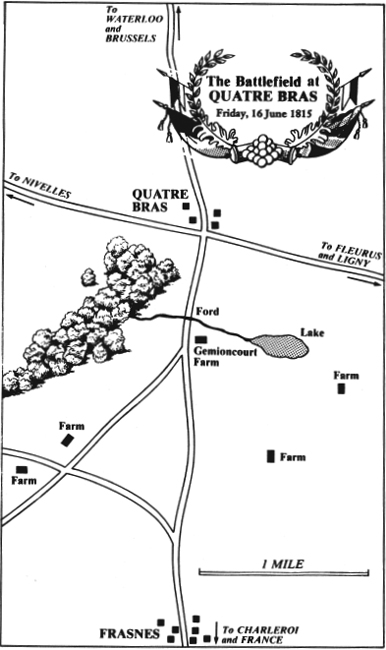
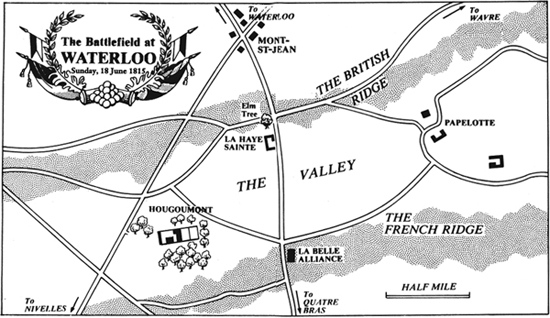
CHAPTER ONE

It was dawn on the northern frontier of France; a border marked only by a shallow stream which ran between the stunted trunks of pollarded willows. A paved high road forded the stream. The road led north from France into the Dutch province of Belgium, but there was neither guardpost nor gate to show where the road left the French Empire to enter the Kingdom of the Netherlands. There was just the summer-shrunken stream from which a pale mist drifted to lie in shadowy skeins across the plump fields of wheat and rye and barley.
The rising sun appeared like a swollen red ball suspended low in the tenuous mist. The sky was still dark in the west. An owl flew over the ford, banked into a beechwood and gave a last hollow call, which was lost in the dawn’s loud chorus that seemed to presage a bright hot summer’s day in this rich and placid countryside. The cloudless sky promised a day for haymaking, or a day for lovers to stroll through heavy-leafed woods to rest beside the green cool of a streambank. It was a perfect midsummer’s dawn on the northern border of France and for a moment, for a last heart-aching moment, the world was at peace.
Then hundreds of hooves crashed through the ford, spattering water bright into the mist. Uniformed men, long swords in their hands, rode north out of France. The men were Dragoons who wore brass helmets covered with drab cloth so the rising sun would not reflect from the shining metal to betray their position. The horsemen had short-barrelled muskets thrust into bucket holsters on their saddles.
The Dragoons were the vanguard of an army. A hundred and twenty-five thousand men were marching north on every road that led to the river-crossing at Charleroi. This was invasion; an army flooding across an unguarded frontier with wagons and coaches and ambulances and three hundred and forty-four guns and thirty thousand horses and portable forges and pontoon bridges and whores and wives and colours and lances and muskets and sabres and all the hopes of France. This was the Emperor Napoleon’s Army of the North and it marched towards the waiting Dutch, British and Prussian forces.
The French Dragoons crossed the frontier with drawn swords, but the weapons served no purpose other than to dignify the moment with a suitable melodrama, for there was not so much as a single Dutch customs officer to oppose the invasion. There were just the mist and the empty roads, and the far-off crowing of cockerels in the dawn. A few dogs barked as the invading cavalrymen captured the first Dutch villages unopposed. The Dragoons hammered their sword hilts against doors and window shutters, demanding to know whether any British or Prussian soldiers were billeted within.
‘They’re all to the north. They hardly ever show themselves here!’ The villagers spoke French; indeed, they thought of themselves as French citizens and consequently welcomed the helmeted Dragoons with cups of wine and offers of food. To these reluctant Dutchmen the invasion was a liberation, and even the weather matched their joy; the sun was climbing into a cloudless sky and beginning to burn off the mist which still clung in the leafy valleys.
On the main highway leading to Charleroi and Brussels the Dragoons were clattering along at a fine pace, almost as if this was an exercise in Provence instead of war. A lieutenant of Dragoons was so dismissive of any danger that he was eagerly telling his Sergeant how the new science of phrenology measured human aptitudes from the shape of a man’s skull. The Lieutenant opined that when the science was properly understood all promotion in the army would be based on careful skull measurements. ‘We’ll be able to measure courage and decisiveness, common sense and honesty, and all with a pair of calipers and a measuring tape!’
The Sergeant did not respond. He and his officer rode at the head of their squadron, and were thus at the very tip of the advancing French army. In truth the Sergeant was not really listening to the Lieutenant’s enthusiastic explanation; instead he was partly anticipating the Belgian girls and partly worrying when this headlong advance would run into the enemy picquets. Surely the British and Prussians had not fled?
The Lieutenant was somewhat piqued by his Sergeant’s apparent lack of interest in phrenology, though the Sergeant’s low and scowling brow ridge undoubtedly betrayed the scientific reason for his inability to accept new ideas. The Lieutenant nevertheless persisted in trying to enlighten the veteran soldier. ‘They’ve done studies on the criminal classes in Paris, Sergeant, and have discovered a remarkable correlation between –’
The remarkable correlation remained a mystery, because the hedgerow thirty yards ahead of the two horsemen exploded with musket-fire and the Lieutenant’s horse collapsed, shot in the chest. The horse screamed. Blood frothed at its teeth as it lashed frantically with its hooves. The Lieutenant, thrown from the saddle, was kicked in the pelvis by a thrashing hoof. He screamed as loudly as his horse that was now blocking the high road with its flailing death throes. The astonished Dragoons could hear the enemy ramrods rattling in their musket barrels. The Sergeant looked back at the troopers. ‘One of you kill that bloody horse!’
More shots hammered from the hedge. The ambushers were good. They had allowed the French horsemen to come very close before they opened fire. The Dragoons sheathed their long swords and drew their carbines, but their aim from horseback was uncertain and the short-barrelled carbine was a weapon of notorious inaccuracy. The Lieutenant’s horse still lashed and kicked on the road. The Sergeant was shouting for his men to advance. A trumpet called behind, ordering another troop to file right into a field of growing wheat. A trooper shot the Lieutenant’s horse, leaning from his saddle to put the bullet plumb into the beast’s skull. Another horse fell, this one with a leg bone shattered by a musket-ball. A Dragoon was lying in the ditch, his helmet fallen into a nettle patch. Horses crashed past the wounded Lieutenant, their hooves spurting mud and road-flints into the air. The Sergeant’s long sword shone silver.
More shots, but this time the gouts of white smoke were scattered more thinly along the hedgerow. ‘They’re retreating, sir!’ the Sergeant shouted to an officer far behind him, then, not waiting for any orders, spurred his horse forward. ‘Charge!’
The French Dragoons swept past the line of the hedge. They could see no enemy in the long-shadowed landscape, but they knew the ambushers had to be close. The Sergeant, suspecting that the enemy infantry was hiding in the mist-skeined wheat field, turned his horse off the lane, forced it through a ditch and so up into the wheat. He saw movement at the far side of the field, close by a dark-leafed wood. The movement resolved into men running towards the trees. The men wore dark blue uniform coats and had black shakos with silver rims. Prussian infantry. ‘There they are!’ The Sergeant pointed at the enemy with his sword. ‘After the bastards!’
Thirty Dragoons followed the Sergeant. They thrust their carbines into the bucket holsters on their saddles and dragged out their long straight-bladed swords. Prussian muskets pricked flame from the wood’s edge, but the shooting was at too long a range and only one French horse tumbled into the wheat. The remaining Dragoons swept on. The enemy picquet that had ambushed the French vanguard was hurrying to the shelter of the wood, but some of them had left their retreat too late and the Dragoons caught them. The Sergeant galloped past a man and cut back with a savage slash of his sword.
The Prussian infantryman clapped his hands to his sword-whipped face, trying to cram his eyes back into their sockets. Another man, ridden down by two Dragoons, choked on blood. ‘Charge!’ The Sergeant was carrying his sword to the infantry among the trees. He could see Prussian soldiers running away in the undergrowth and he felt the fierce exultation of a cavalryman given a helpless enemy to slaughter, but he did not see the battery of guns concealed in the deep shadows at the edge of the wood, nor the Prussian artillery officer who shouted, ‘Fire!’



